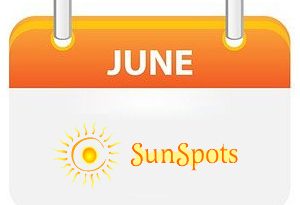Sunspots – December
December 4, 1972
On December 4, 1972 the minimum wage for adults in British Columbia was set at $2 an hour, the highest in Canada.
Economic doom was predicted, especially when the NDP government promised a further boost to $2.50 an hour by mid-1974. Even more alarming, the new bill applied for the first time to women as well as men.
“That anniversary steak dinner you promised your wife,” the restaurant industry told The Vancouver Sun, “will cost between 20 and 40 per cent more in June, 1974. And your morning coffee at that little diner down the street might not be available at all because the diner will be closed.”
There were cries of alarm from the hotel industry and from nursing homes, too.
Prices at the time? You could see Frank Zappa live at the Agrodome for $3.50. The best-selling paperback, The Primal Scream, was $1.50. A loaf of raisin bread was 35 cents—roughly 10 minutes work. But gas was 49.9 cents per gallon. So to buy four gallons on the minimum wage then would take one hour’s work. Today, with the minimum wage at $8, to buy those same four gallons (18.2 litres) you’d need to work about two hours and 15 minutes.
December 5, 1923
It took time before our city directories took notice of local radio. In 1926 Henderson’s Directory listed six radio stations in the city, where there had been none shown the year before. Yet we know that CFQC (today’s CFUN) signed on in 1922, making it the oldest radio station in Western Canada. On December 5, 1923, radio was used for the first time in a Vancouver mayoralty campaign: candidate W.R. Owen gave a ten-minute speech over CJCE, which happened to be co-owned by The Vancouver Sun. (The other owner was the Sprott-Shaw School of Commerce.)
William Reid Owen was a realtor and insurance agent active in the Mount Pleasant area, and had been its first blacksmith. That radio chat may have been the deciding factor in the election, because he squeaked past his opponent L.D. Taylor by just 53 votes.
Owen’s timing was good: Vancouver was thriving again after a slump following the First World War. The city’s population was 130,000, a growth of 13,000 in two years. But, despite the good times and his campaign slogan (“I stand for necessities before fads and frills”), Owen’s luck didn’t hold: L.D. Taylor beat him in the next election in 1925 by 640 votes.
December 6, 1969
They expected about 3,500 people to visit the Bloedel Conservatory on opening day, December 6, 1969. More than 11,000 showed up. It’s still a great place to visit, especially on a wet, chilly December day. Dozens of species of colorful birds fly freely through the foliage, from tiny, flitting Button Quail and Gold-breasted Waxbills to the big Moluccan Cockatoo, the Blue and Gold Macaw and Rosie the Parrot, who—perched on apprentice gardener Tricia Meneghello’s arm—can imitate the sound of a cell phone and does a pretty good cough.
The conservatory was built thanks largely to a $1.25 million donation through the Bloedel Foundation from lumber magnate Prentice Bloedel and his wife Virginia, and smaller amounts from the city and provincial governments. Mayor Tom Campbell was joined by Mr. and Mrs. Bloedel and Bill Livingstone, the Vancouver parks board assistant superintendent “responsible for the main creative inspiration.”
“More than 300 varieties of tropical plants are on display,” the Sun‘s Lorne Mallin wrote, “from Africa, Mexico, Vietnam, Brazil, Java, Colombia, West Indies, China, Egypt, Fiji, Arizona, Florida, California and Hawaii.” Supervisor Alex Downie oversees the constant work necessary as the seasons change (lots of poinsettias on display right now) or as plants grow too tall to fit under the geodesic dome.
It’s nice and warm under those 1,490 plastic bubbles, too. What more could you ask?
December 12, 1968
Vancouver Sun columnist Allan Fotheringham was prescient in his comment on the opening December 12, 1968 of the 29-storey MacMillan Bloedel Building at Georgia and Thurlow in downtown Vancouver. “No major new building in town,” Fotheringham wrote, “will dare to build out to the property line now that Massey-Erickson have shown the advantages of stepping back to leave some welcome space for the poor pedestrians.”
Architects Arthur Erickson and Geoff Massey accomplished something else with the $14.5 million new building: its deeply recessed windows and the gentle tapering of its two abutting towers give it a handsome, heavy elegance. Eleven of the 29 floors were occupied by MacBlo; the others were to be rented out.
The company’s CEO, J.V. Clyne, told 250 invited guests at the opening: “This home office in Vancouver will testify that MacMillan Bloedel is a B.C. company, founded here and run from here.” Alas, no more. In November 1999 Weyerhaeuser, the big U.S. forest products company, became even bigger with a $3.6 billion takeover of MacBlo.
Today, with its original owner moved out, the building is known as, simply, 1075 Georgia Street West.
December 13, 1934
Gerry McGeer was elected mayor of Vancouver for the first time on December 13, 1934 with the largest lead in Vancouver history: 25,000 votes out of 44,000 cast. He wasted no time getting into action: In the first week of his term he confiscated 1,000 slot machines in the city. He started a push for a new city hall, and insisted it go away out at West 12th and Cambie, when the sentiment (especially within the business community) was to keep it downtown. His role in the April, 1935 labor strife that led to his Victory Square reading of the Riot Act—to oversimplify, McGeer (backed by 200 police officers) sided with the power structure against unemployed men from the relief camps—generates argument to this day. TIME Magazine, in likely its first-ever reference to a mayor of Vancouver, called McGeer “bumptious.” He still looms large in the city’s past: McGeer has more index entries in books on Vancouver’s history than anyone else. Read Mayor Gerry : the remarkable Gerald Grattan McGeer, by David Ricardo Williams.
December 18, 1929
There was a time when Canada had a national broadcasting service, but only on the trains. In 1923, when radio was in its infancy, Henry Thornton, the man who ran Canadian National Railways — also quite young — wanted to make his line more attractive to passengers than the CPR. One thing he did was put radios in the cars. Operators rode in the cars and tuned in the nearest stations, which passengers listened to on earphones.
Thornton had stations set up in major cities along the railway’s route, each with its own programming. Westernmost was CNRV in Vancouver (“The Voice of the Pacific”), started in 1925 with studios in the CN station at 1150 Main Street, which today is Pacific Central Station. In 1927 it began broadcasting Canada’s first regular drama series, starring the CNRV Players.
On December 18, 1929, Vancouverites were reading in The Vancouver Sun that the CNR would launch a Trans-Canada radio network, with programs originating initially from Toronto. It would be the longest single radio hookup on the continent.
A new entity called the Canadian Radio Commission took over the CNR’s radio stations in 1934, and two years after that the Commission changed its name to the Canadian Broadcasting Corporation.
December 19, 1915
The Connaught Tunnel became the longest in North America to that time when its two parts were connected on December 19, 1915. The CPR planned the $6 million tunnel to eliminate miles of snowsheds over the line, and to lower the summit that had to be reached to get over Rogers Pass.
“With no ceremony whatever,” our report ran, “except the ceremony of touching off the fuse that fired the big blast, the centre heading of the big five-mile tunnel of the Canadian Pacific Railway company under Mt. McDonald, at the highest point in the Selkirk range of the Rocky mountains, was blown through this morning.”
Deep within the mountain itself two crews had been burrowing their way toward each other for two years. Now only a thin barrier of rock separated them.
A group of men gathered for the 8:00 a.m. blast, led by John G. Sullivan, the railway’s chief engineer. Asked if he was sure the two holes would exactly meet, Mr. Sullivan said: ‘The sides will be within one-half inch of each other.’ They were.
The two groups of workmen groped through the dust of the explosion, grinning, and shook each others’ hands.
December 20, 1911
Professional hockey came to Vancouver when the Patrick brothers, Lester (10 days short of his 28th birthday) and Frank (one day short of his 26th) opened the Denman Arena. It was a big place, squatting at the north end of Denman Street at Georgia and holding 10,000 people. When it opened December 20, 1911, it was the world’s largest artificial ice rink.
The Patrick brothers created many of hockey’s rules and features, including unrestricted passing in the central zone, the blue line, the penalty shot, the play-off series . . . they even changed the rule that said a goalie must stand at all times. They also created the Pacific Coast Hockey Association, consisting of the New Westminster Royals, the Victoria Aristocrats, and the Vancouver Millionaires. When the Millionaires got Fred “Cyclone” Taylor to join the team, it brought them the 1915 Stanley Cup when they beat the Ottawa Senators in three straight games.
Dempsey and Braddock fought in the Denman Arena, Rudolph Valentino judged a beauty contest there and Arthur Conan Doyle (creator of Sherlock Holmes) gave a speech in the building. But it burned down August 20, 1936, just hours after a Max Baer boxing exhibition. The city fire marshal, J.A. Thomas, fumed that the building had been the worst fire trap in Vancouver “ever since it was built.” If it had started to burn with the crowd still in it, he said, “the death toll could easily have reached 1,000.”
December 26, 1908
There are a couple of Vancouver-related stories connected to a boxing match fought at Rushcutter’s Bay, near Sydney in Australia, on December 26, 1908.
It was a title match. In one corner was world heavyweight champ Tommy Burns, 27, a Canadian (whose real name was Noah Brusso, born in Hanover, Ontario) who had won the title February 23, 1906 in Los Angeles, defeating Marvin Hart. In the other corner was Galveston, Texas-born Jack Johnson, 30, bigger than Burns, and eager to become the first black heavyweight champion. Other contenders had refused to fight Johnson because he was black. Burns didn’t care.
Johnson slowly and methodically battered Burns into submission. “The end came in the 14th round,” the newspapers read, “when the police, seeing Burns tottering and unable to defend himself from the savage blows of his opponent, mercifully stopped the fight.”
And the local connections? Johnson’s first fight after winning the championship was a non-title bout in Vancouver March 10, 1909. (His opponent was a fellow named Victor McLaglen, who later became a well-known Oscar-winning movie actor.)
And Tommy Burns died in Vancouver at age 73 on May 10, 1955 while visiting a friend here.
December 27, 1965
The Vancouver Sun has had four homes since its first edition February 12, 1912, but headquarters for the longest stretch was in the Pacific Press Building at 2250 Granville Street. The paper moved in on December 27, 1965. This would be its home for the next 31 years.
Pacific Press had started in 1958 as a response to the rising costs of producing newspapers. First, the Sun and the Province merged their mechanical and financial departments, similar to changes happening in two-newspaper cities all over North America. The move by both papers to the 2250 Granville building was the next step.
The two papers had been virtually next-door neighbors for more than 50 years already. When the Sun started in 1912 it was at 125 West Pender, just around the corner from the Province, housed then in the Carter-Cotton Building—still there at the southeast corner of Hastings and Cambie. Then, in March 1937, a fire destroyed the Sun‘s business and editorial offices. (There was just one casualty: the janitor suffered minor burns and smoke inhalation.)
The Sun simply bought the World Building across the street at 100 West Pender, a funky green-topped skyscraper that had once been home to the now-vanished Vancouver World. The Sun staff walked across the street and set up shop, and were there until the 1965 move.
The paper’s next move, in 1997, brought them to Granville Square.




